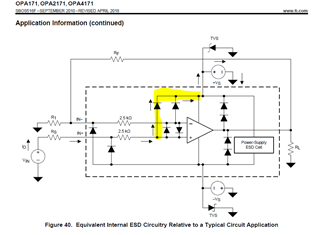Other Parts Discussed in Thread: TS321, LM358, OPA348, TLV341, LM2904B, LM358B, OP27, TLE2027, TLE2141
Hi Support team
my customer is looking for non- internal clamp diode to VCC (see following yellow) and similar function w/ OPA171
do we have it?

This thread has been locked.
If you have a related question, please click the "Ask a related question" button in the top right corner. The newly created question will be automatically linked to this question.
Hello Red,
Many old bipolar devices do not have diodes to VCC+. TS321 , LM358
For low voltage, try TLV341 or OPA348
Hi Ron,
How about the B version of TS321 & LM358?
Are those new design also remove the diodes to VCC+?
Red,
LM358B and LM2904B also also fine. No diode to VCC+ on them.
TS321B is not a valid device name.
Hi Ron,
after checked w/ customer,
They cannot use LM358 because its spec and channel number are different with OPA171.
need your kindly help to check if we have alternative solution which the OPA between input and Vcc without internal clamp diode and the spec is the same or ever better than OPA171.
your kindly feedback is highly appreciated
thanks a lot
Hi Kai,
The part you select looks very old, OP27, TLE2027 or TLE2141
My question is that how to select it in TI website? what is sorting parameter?
Hey Red,
If you open the link that Kai replied with above, it tells you which parameters he used to refine his search.
All the best,
Carolina
Hi Red,
the legacy OPAmps are built on a "huge" die compared to the modern OPAmps. Bigger structures on the die are less vulnerable to ESD and EOS (electrical overstress). This is why the very first OPAmps are not having ESD protecion diodes at the inputs. Modern OPAmps, on the other hand, urgently need ESD protection measures. You couldn't even handle them during assembling and soldering without the internal protection measures.
So, if you are looking for an OPAmp without input protection diodes, you automatically end up with a "very old" legacy OPAmp.
By the way, "very old" does not necessarily mean "very bad"...
Why is the customer searching for an OPAmp without input protection diodes at all? Maybe he can follow a different approach?
Kai